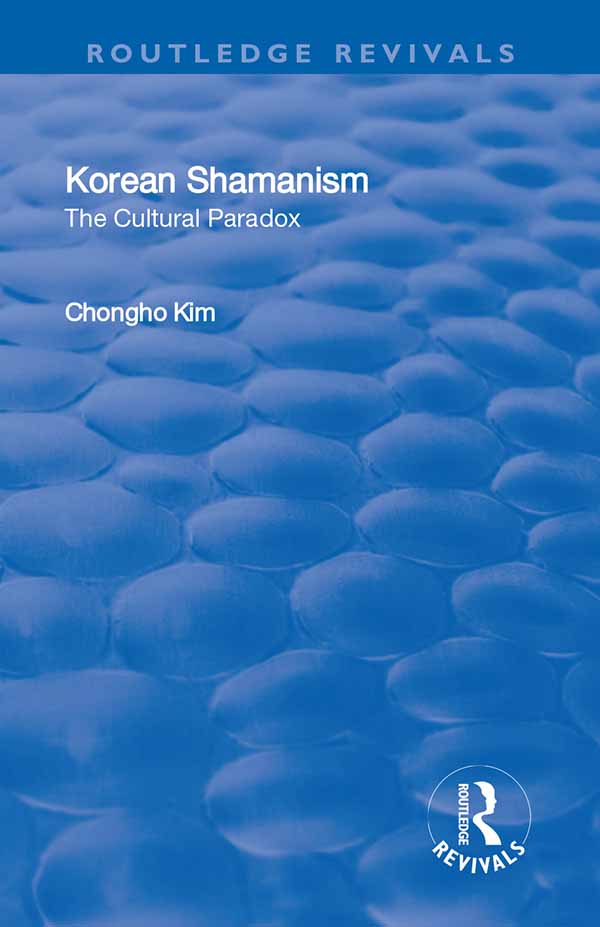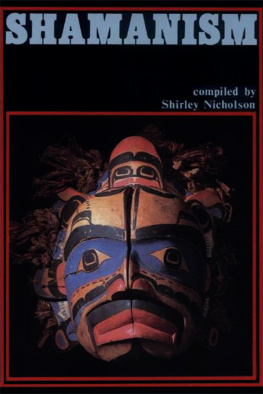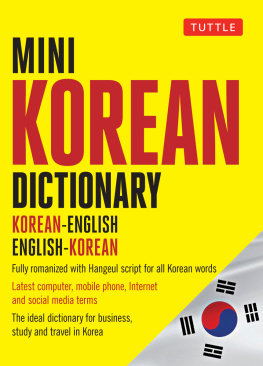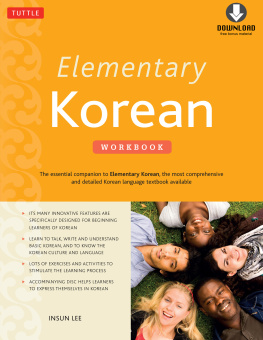Chongho Kim - Korean Shamanism
Here you can read online Chongho Kim - Korean Shamanism full text of the book (entire story) in english for free. Download pdf and epub, get meaning, cover and reviews about this ebook. year: 2017, publisher: Taylor & Francis (CAM), genre: Religion. Description of the work, (preface) as well as reviews are available. Best literature library LitArk.com created for fans of good reading and offers a wide selection of genres:
Romance novel
Science fiction
Adventure
Detective
Science
History
Home and family
Prose
Art
Politics
Computer
Non-fiction
Religion
Business
Children
Humor
Choose a favorite category and find really read worthwhile books. Enjoy immersion in the world of imagination, feel the emotions of the characters or learn something new for yourself, make an fascinating discovery.

- Book:Korean Shamanism
- Author:
- Publisher:Taylor & Francis (CAM)
- Genre:
- Year:2017
- Rating:3 / 5
- Favourites:Add to favourites
- Your mark:
- 60
- 1
- 2
- 3
- 4
- 5
Korean Shamanism: summary, description and annotation
We offer to read an annotation, description, summary or preface (depends on what the author of the book "Korean Shamanism" wrote himself). If you haven't found the necessary information about the book — write in the comments, we will try to find it.
Korean Shamanism — read online for free the complete book (whole text) full work
Below is the text of the book, divided by pages. System saving the place of the last page read, allows you to conveniently read the book "Korean Shamanism" online for free, without having to search again every time where you left off. Put a bookmark, and you can go to the page where you finished reading at any time.
Font size:
Interval:
Bookmark:

Why do Koreans use shamanic ritual even though prejudice against shamanism is universal? Why do so many Koreans employ a practice that is widely stigmatized and despised as superstition?
Shamanism occupies a contradictory position within the Korean cultural system. This has led to the periodical suppression of shamanism and has also, paradoxically, ensured its survival throughout Korean history. This book examines the place of shamans within contemporary society, exploring shamanism as a cultural practice in which people make use of shamanic ritual, and disputing the prevalent view that shamanism is popular culture, womens religion, symbolic healing or performing arts. Kim also disputes the common view among medical anthropologists that places shamanism firmly within the realm of traditional medicine.
Drawing on case studies within Korea, Chongho Kim presents a study of indigenous anthropology with ethnographic material drawn from an insiders perspective and offers an engaging understanding of the appeal of this indigenous folk practice in a highly industrial society. Directly confronting the prejudice against shamans and their paradoxical situation in a modern society such as Korea, this book reveals the cultural discrepancy between two worlds in Korean culture, the ordinary world and the shamanic world, and shows that these two worlds cannot be reconciled with each other. Kim explains that it is the difference between them that explains why shamans are necessary but also despised.
Focusing on ordinary people who make use of shamans, rather than focusing merely on the way of the shaman, this unique study of shamanism offers a significant contribution to the growing field of studies in indigenous anthropology and indigenous religions. Yet Korean Shamanism: The Cultural Paradox is not merely a piece of academic writing: it provides an enjoyable and captivating read for a wide range of readers through retelling the stories-never-to-be-told involving shamanic ritual.
First published 2003 by Ashgate Publishing
Reissued 2018 by Routledge
2 Park Square, Milton Park, Abingdon, Oxon 0X14 4RN
711 Third Avenue, New York, NY 10017, USA
Routledge is an imprint of the Taylor & Francis Group, an informa business
Copyright Chongho Kim 2003
The author has asserted his moral right under the Copyright, Designs and Patents Act, 1988, to be identified as the author of this work.
All rights reserved. No part of this book may be reprinted or reproduced or utilised in any form or by any electronic, mechanical, or other means, now known or hereafter invented, including photocopying and recording, or in any information storage or retrieval system, without permission in writing from the publishers.
Notice:
Product or corporate names may be trademarks or registered trademarks, and are used only for identification and explanation without intent to infringe.
Publishers Note
The publisher has gone to great lengths to ensure the quality of this reprint but points out that some imperfections in the original copies may be apparent.
Disclaimer
The publisher has made every effort to trace copyright holders and welcomes correspondence from those they have been unable to contact.
Typeset by Manton Typesetters, Louth, Lincolnshire, UK.
A Library of Congress record exists under LC control number: 2002027803
ISBN 13: 978-1-138-71051-1 (hbk)
ISBN 13: 978-1-315-19815-6 (ebk)
Series Editors
Graham Harvey, King Alfreds College, UK
Lawrence Martin, University of Wisconsin Eau Claire, USA
Tabona Shoko, University of Zimbabwe, Zimbabwe
Ashgates Vitality of Indigenous Religions series offers an exciting new cluster of research monographs, drawing together volumes from leading international scholars across a wide range of disciplinary perspectives. Indigenous religions are vital and empowering for many thousands of indigenous peoples globally, and dialogue with, and consideration of, these diverse religious life-ways promises to challenge and refine the methodologies of a number of academic disciplines, whilst greatly enhancing understandings of the world.
This series explores the development of contemporary indigenous religions from traditional, ancestral precursors, but the characteristic contribution of the series is its focus on their living and current manifestations. Devoted to the contemporary expression, experience and understanding of particular indigenous peoples and their religions, books address key issues which include: the sacredness of land, exile from lands, diasporic survival and diversification, the indigenization of Christianity and other missionary religions, sacred language, and re-vitalization movements. Proving of particular value to academics, graduates, postgraduates and higher level undergraduate readers worldwide, this series holds obvious attraction to scholars of Native American studies, Maori studies, African studies and offers invaluable contributions to religious studies, sociology, anthropology, geography and other related subject areas.
OTHER TITLES IN THE SERIES
Sacred Landscapes and Cultural Politics
Edited by Philip P. Arnold and Ann Grodzins Gold
ISBN 0 7546 1569 3
Maya Identities and the Violence of Place
Charles D. Thompson, Jr.
ISBN 0 7546 1377 1
To my late mother and my wife Misook
who suffered the most from this research
This book is a study of the place of shamans {mudang) within contemporary Korean society, based on fieldwork both in the small town of Soy, some 150 km from Seoul, and in the city of Seoul itself. In the book, I explore what I call the cultural paradox of shamanism within Korean culture: why do Koreans use shamans even though prejudice against shamanism is universal and much consultation of shamans goes on in secret? Why do so many Koreans employ a practice that is widely stigmatized and despised as superstition?
I argue that shamanism has a contradictory position within the Korean cultural system. This contradictory position has led to the periodic suppression of shamanism and has also, paradoxically, ensured its survival throughout Korean history. At the same time, it is the contradictions surrounding shamanism which generate the power of shamanic healing. There is a cultural discrepancy between two worlds in Korean culture: the ordinary world and the shamanic world. These two worlds cannot be reconciled with each other, and it is the difference between them which explains why shamans are necessary, but also despised.
Although this book is a study of shamanism, shamans and their arguments are not my main concern. Rather, I focus on the ordinary people who make use of shamans. Throughout this research, I have tried to understand their point of view as closely as possible. I have approached shamanism, not as the way of the shaman, nor as a belief system, but as a cultural practice in which people make use of shamanic ritual. In several respects, this has led me to very different conclusions to existing studies of shamanism in Korea and elsewhere.
Previous studies have mainly focused on shamans and their views. However, I argue that shaman-centred studies are unable fully to comprehend the cultural paradox of shamanism. Shamans and their clients interact in a cultural environment, the central feature of which is the contradiction between shamanism and public culture. For this reason, this study is not focused on shamans, but on ordinary people, with the problems they refer to the shamans, and the ways in which they use the framework of shamanism to manage their problems.
Next pageFont size:
Interval:
Bookmark:
Similar books «Korean Shamanism»
Look at similar books to Korean Shamanism. We have selected literature similar in name and meaning in the hope of providing readers with more options to find new, interesting, not yet read works.
Discussion, reviews of the book Korean Shamanism and just readers' own opinions. Leave your comments, write what you think about the work, its meaning or the main characters. Specify what exactly you liked and what you didn't like, and why you think so.







